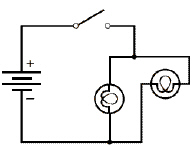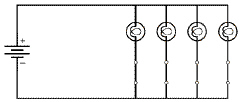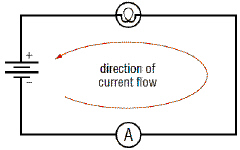Multiple Choice
Identify the
choice that best completes the statement or answers the question.
|
|
|
1.
|
Which of the following diagrams represents a circuit that contains a two-cell
battery, two lamps, and an open switch, connected in series?
|
|
|
2.
|
In a circuit diagram, the following symbol would represent a(n)  a. | variable DC power supply | b. | electric cell | c. | three-cell
battery | d. | lamp |
|
|
|
3.
|
The circuit represented by the following diagram is a  a. | series circuit | b. | parallel circuit | c. | all of the
above | d. | none of the above |
|
|
|
4.
|
Choose the best description of the circuit represented by the following circuit
diagram.  a. | A two-cell battery, with four lamps, each with its own closed switch, connected in
parallel. | b. | An electric cell, with four lamps, each with its own open switch, connected in
series. | c. | A two-cell battery, with four electric motors, each with its own closed switch,
connected in parallel. | d. | A two-cell battery, with four lamps, each with
its own closed switch, connected in series. |
|
|
|
5.
|
What device is used to measure potential difference?
a. | voltmeter | b. | ammeter | c. | ohmmeter | d. | electroscope |
|
|
|
6.
|
A parallel circuit contains four identical lamps. The current through the energy
source is 3.5 A. The total resistance of the circuit is 7.0 W. What are
the voltage across each energy source and across each lamp?
a. | energy source: 2 V; lamp: 2 V | b. | energy source: 2 V; lamp: 24.5
V | c. | energy source: 24.5 V; lamp: 24.5 V | d. | energy source: 24.5 V; lamp: 2
V |
|
|
|
7.
|
What must be present for an electrical device to operate?
a. | a flow of protons | b. | a flow of electrons | c. | a flow of
neutrons | d. | all of the above |
|
|
|
8.
|
An ammeter is correctly connected to a circuit in which of the following
figures?
a. |  | b. |  | c. | all of the above | d. | none of the
above |
|
|
|
9.
|
A series circuit has three identical lamps. The potential difference of the
energy source is 10 V. The total resistance of the lamps is 50 W. What is
the current through each lamp?
a. | 5.0 A | b. | 0.2 V | c. | 0.2 W | d. | 0.2 A |
|
|
|
10.
|
Which unit is used to measure electrical resistance?
a. | volts | b. | joules | c. | ohms | d. | amperes |
|
|
|
11.
|
Which of the following is an example of a circuit connected in
series?
|
|
|
12.
|
When calculating the potential difference across a resistor, Ohm’s law
would be arranged in which of the following ways?
a. |  | b. |  | c. | V = IR | d. | none of the
above |
|
|
|
13.
|
Which of the following symbols is used to represent a resistor in a circuit
diagram?
|
|
|
14.
|
Which of the following is an example of a factor that influences the internal
resistance of a conductor?
a. | length of the conductor | b. | cross-sectional area | c. | temperature | d. | all of the
above |
|
|
|
15.
|
Which of the following is a true statement regarding internal
resistance?
a. | Thinner wires have less internal resistance than thicker ones. | b. | Longer wires have
greater internal resistance than shorter wires. | c. | The ability of a material to conduct
electricity is determined by how freely protons can move within the material. | d. | Internal resistance
decreases when temperature increases. |
|
|
|
16.
|
A measure of the difference in electric potential energy per unit of charge
between two points is called
a. | voltage | b. | resistance | c. | current | d. | none of the
above |
|
|
|
17.
|
The resistance of a load can be calculated by
a. | dividing the voltage across the load by the amount of current flowing through
it | b. | multiplying the voltage across the load by the amount of current flowing through
it | c. | dividing the current flowing through a load by the voltage across
it | d. | adding the voltage across the load to the amount of current flowing through
it |
|
|
|
18.
|
A current of 0.5 A is passing through a 1000 W
resistor. What is the potential difference across the resistor?
a. | 50 V | b. | 200 V | c. | 500
V | d. | 2000 V |
|
|
|
19.
|
A load has 1.0 A of current flowing through it. The voltage across the load is
5.0 V. What is the resistance of the load?
a. | 0.2 W | b. | 0.5 W | c. | 5.0 W | d. | 5.0 V |
|
|
|
20.
|
A 210 W resistor is connected to a power supply set
at 21 V. What is the current going through the resistor?
a. | 0.01 A | b. | 0.1 A | c. | 1
A | d. | 10 A |
|